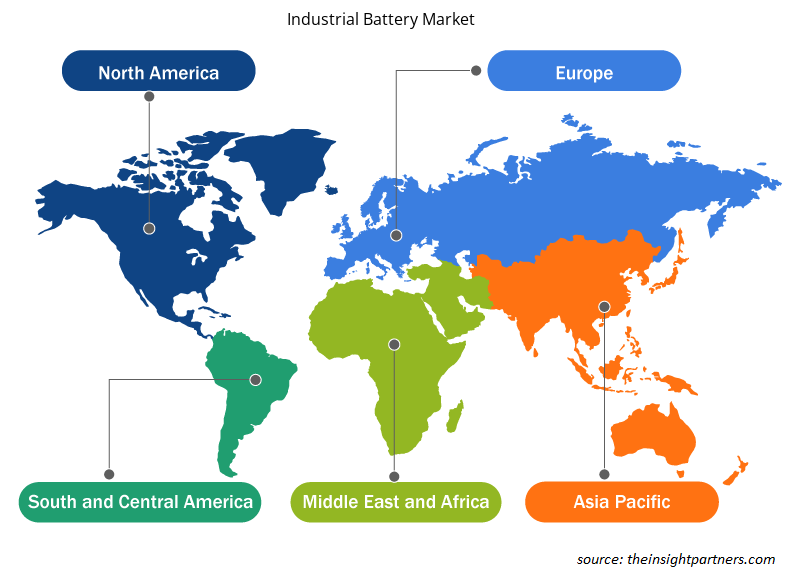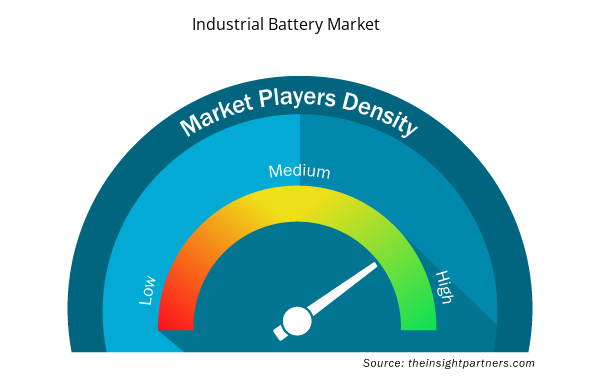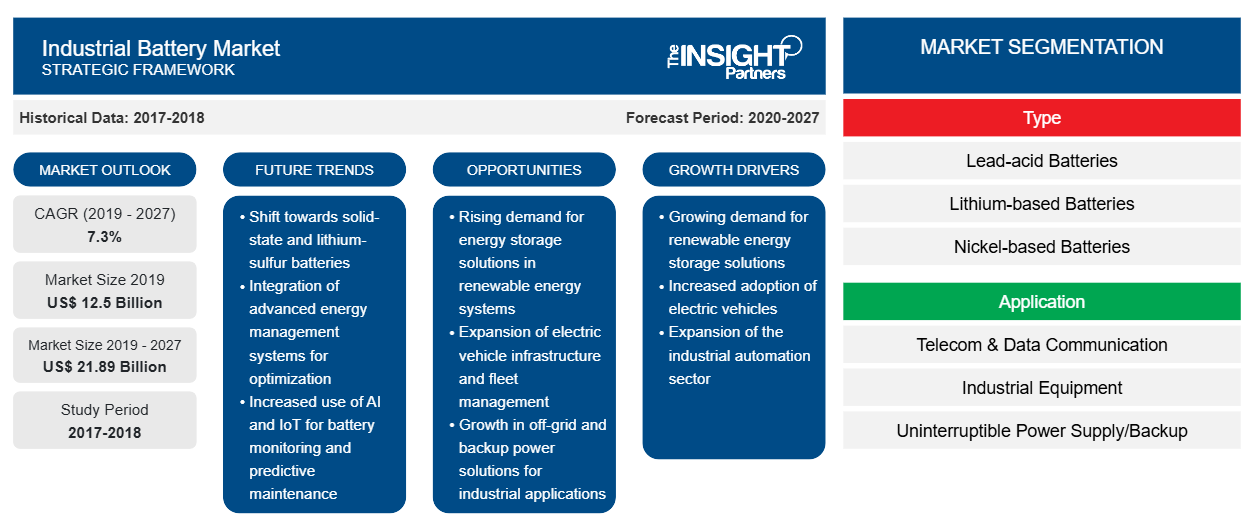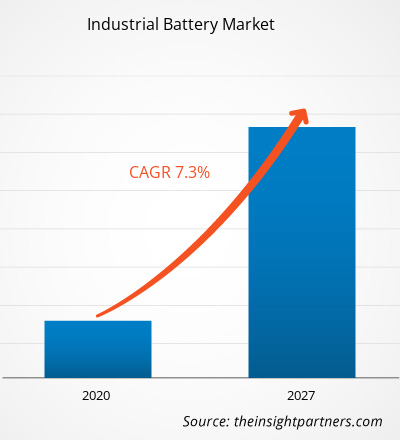2019 年工业电池市场价值为 125.019 亿美元,预计 2020 年至 2027 年的复合年增长率为 7.3%,到 2027 年达到 218.935 亿美元。
工业电池是专门设计的电池,可以在极端温度、更多振动和频繁使用等恶劣的工业温度下工作。工业电池性能更佳,设计更强大。在目前的市场情况下,各公司正在努力开发高效电池,以满足不同的工业电池需求。预计全球工业电池市场在预测期内将实现令人瞩目的增长。预计在预测期内,锂电池的需求将大幅增长。由于锂电池具有低排放、更长的使用寿命和可回收性等优势,预计锂电池在各个垂直领域的应用都将增长。在市场上运营的公司正专注于开发新产品,以获得强大的客户群并获得可观的市场份额。
北美国家(例如美国)的政府正在不断采取措施提高制造业的生产力。例如,提供最新技术以简化制造流程并增加仓库数量。这些仓库中自动化技术的使用预计将影响北美工业电池市场的增长。政府增加的支出将推动任何技术的发展。在北美地区,政府在技术进步活动上的支出相当高,这为任何企业的蓬勃发展创造了有利的环境。物联网、大数据和先进技术在该地区得到了广泛的采用。这些技术反过来又推动了增强网络的需求以及对工业电池的需求。工业电池市场中的一些新兴技术是新一代锂离子 (Li-ion) 电池、锂硫电池、固态电池、铝离子电池等。
定制此报告以满足您的需求
您可以免费定制任何报告,包括本报告的部分内容、国家级分析、Excel 数据包,以及为初创企业和大学提供优惠和折扣
- 获取此报告的关键市场趋势。这个免费样品将包括数据分析,从市场趋势到估计和预测。
市场洞察
不间断电源并网解决方案推动工业电池需求 uninterruptable power supply drives the demand for industrial battery
最突出和最重要的可再生能源类型是储存在电网中的太阳能和风能。然而,云层遮挡太阳或风流波动可能会导致能源生产过程发生变化。这种变化需要灵活的电网系统来储存能源。工业电池储能系统帮助电网运营商在电力数量超过电力需求时节省电力。因此,这些系统的广泛采用有助于提高电力供应系统在发电、输电和配电活动方面的可靠性和灵活性。在输电和配电过程中,电池储能系统处理资产延期、谐波抑制、电压支持、频率调节和电能质量等各个方面。电能时移、可再生能源时移、基载平衡和削峰以及可再生能源容量稳固是使用电池储能系统进行电网连接解决方案的其他好处,这些好处推动了这些系统的采用,从而推动了工业电池市场的增长。市场参与者正在想出新的电网解决方案,以保持在工业电池市场的竞争优势。例如,西门子提供智能电网解决方案 SIESTORAGE。SIESTORAGE 能够克服电力供应三个主要方面所面临的挑战,即优化电网连接、为现代电网提供弹性能源以及支持大型能源消费者。此外,2015 年 7 月,EDP Distribuicao 向西门子位于葡萄牙埃武拉的 SIESTORAGE 发出了 Storage InovGrid 招标。SIESTORAGE 系统为 EDP 的电网稳定提供电压调节、能源备份和调峰等服务,并将智能电网的好处复制到电网运营商身上。
类型洞察
在类型细分中,铅酸电池在全球工业电池市场中占据最大份额。铅酸电池成本低、性能高、易于回收、充电简单。铅酸电池成本低、使用寿命长,应用范围广泛。然而,这种电池不适合持续高负荷;而且,它的体积能量密度相对较低,这使得它们在能源管理应用中不太可行;因此,它主要用于电力应用。这种电池的进步仍在进行中,这可能使它成为能源管理更可行的选择。
应用程序洞察
工业电池市场按应用细分为电信和数据通信、工业设备、不间断电源 (Ups)/备用电源、采矿、船舶等。工业设备部门在全球工业电池市场中占据主导地位。物联网、人工智能(AI)、大数据分析、网络通信、云计算和机器学习技术等日益发展的工业 4.0 趋势标志着企业工作方式和与客户互动方式的重大变化。这些不断发展的技术正在提供创新的工业设备解决方案,支持高效设备的生产和交付。
公司通常采用并购策略来扩大其全球业务范围并满足不断增长的需求。这种策略主要见于北美和欧洲。工业电池市场的参与者采用扩张和投资研发的策略来扩大全球客户群,这也使参与者能够在全球范围内保持其品牌名称。以下列出了最近的一些收购;
2019 年:East Penn 宣布收购 Navitas Systems 的多数股权。此次收购预计将支持 Motive Power Battery 产品的扩展。2019
年:Saft 宣布收购 Go Electric Inc. 100% 的股份,Go Electric Inc. 是一家总部位于美国的开发商,为微电网和商业及工业客户提供分布式能源弹性解决方案。
工业电池市场区域洞察
Insight Partners 的分析师已详尽解释了预测期内影响工业电池市场的区域趋势和因素。本节还讨论了北美、欧洲、亚太地区、中东和非洲以及南美和中美洲的工业电池市场细分和地理位置。

- 获取工业电池市场的区域具体数据
工业电池市场报告范围
| 报告属性 | 细节 |
|---|---|
| 2019 年市场规模 | 125亿美元 |
| 2027 年市场规模 | 218.9亿美元 |
| 全球复合年增长率(2019 - 2027) | 7.3% |
| 史料 | 2017-2018 |
| 预测期 | 2020-2027 |
| 涵盖的领域 | 按类型
|
| 覆盖地区和国家 | 北美
|
| 市场领导者和主要公司简介 |
|
工业电池市场参与者密度:了解其对业务动态的影响
工业电池市场正在快速增长,这得益于终端用户需求的不断增长,而这些需求又源于消费者偏好的不断变化、技术进步以及对产品优势的认识不断提高等因素。随着需求的增加,企业正在扩大其产品范围,进行创新以满足消费者的需求,并利用新兴趋势,从而进一步推动市场增长。
市场参与者密度是指在特定市场或行业内运营的企业或公司的分布情况。它表明相对于给定市场空间的规模或总市场价值,有多少竞争对手(市场参与者)存在于该市场空间中。
在工业电池市场运营的主要公司有:
- C&D 技术公司
- 东宾夕法尼亚制造公司
- 能源系统公司
- 埃克塞德工业有限公司
- 通用电气公司
免责声明:上面列出的公司没有按照任何特定顺序排列。

- 了解工业电池市场顶级关键参与者概况
工业电池市场——按类型
- 铅酸电池
- 锂电池
- 镍基电池
- 其他的
工业电池市场 – 按应用分类
- 电信和数据通信
- 工业设备
- UPS/备用电源
- 电网级储能
- 矿业
- 海洋
- 其他的
全球工业电池市场(按区域)
北美
- 我们
- 加拿大
- 墨西哥
欧洲
- 法国
- 德国
- 意大利
- 英国
- 俄罗斯
- 欧洲其他地区
亚太地区
- 中国
- 印度
- 韩国
- 日本
- 澳大利亚
- 亚太其他地区
中东和非洲
- 南非
- 沙特阿拉伯
- 阿联酋
- 中东和非洲其他地区
南美洲
- 巴西
- 阿根廷
- 南美洲其他地区
公司简介
- C&D 技术公司
- 东宾夕法尼亚制造公司
- 能源系统公司
- 埃克塞德工业有限公司
- 通用电气公司
- GS汤浅国际有限公司
- LG化学
- 松下公司
- 罗伯特·博世有限公司
- 法国帅福集团
- 历史分析(2 年)、基准年、预测(7 年)及复合年增长率
- PEST 和 SWOT 分析
- 市场规模价值/数量 - 全球、区域、国家
- 行业和竞争格局
- Excel 数据集



Report Coverage
Revenue forecast, Company Analysis, Industry landscape, Growth factors, and Trends

Segment Covered
This text is related
to segments covered.

Regional Scope
North America, Europe, Asia Pacific, Middle East & Africa, South & Central America

Country Scope
This text is related
to country scope.
常见问题
The Industrial Equipment sector is the leading industry in the market, which comprises machinery, large scale process, and construction industry plants. The growing industry 4.0 trends, such as IoT, Artificial Intelligence (AI), big data analysis, networked communications, cloud computing, and machine learning technologies, are marking a substantial change in the businesses model and the way of attracting customers. Such growing technologies are offering innovative industrial equipment solutions that support the production and delivery of efficient equipment. In order to operate a warehouse or heavy machinery, the need for material handling equipment batteries is necessary. Lithium-ion batteries are ideally used for the equipment used in various industries, such as food and beverage and tissue industries. Increasing use of industrial equipment in areas such as airport ground support, lift trucks, sweepers, and scrubbers, and automatic guided vehicles (AGV) is propelling the growth of industrial battery market.
The APAC region led the Industrial Battery market in 2019 as the factors such as the growing industrial equipment, mining, and marine industries, stringent environmental regulations, and reduced labor costs associated with battery recycling are the factors boosting the APAC industrial battery market growth.
Governments across the world are focusing on expanding the reach of digitization and promoting the utilization of several electronic devices, and have become the most important storage technology in the areas of portable and mobile applications (e.g., laptop, cell phone, electric bicycle, and electric car). Other important uses of lithium-ion batteries include storage in electrical grids. Moreover, the performance of Lithium-ion batteries (LIBs) used in grid-level energy storage systems is analyzed by service providers with regard to frequency regulation, peak shifting, integration with renewable energy sources, and power management. The increasing requirement of lithium-ion batteries in various applications is one of the major factors driving the industrial battery market.
Trends and growth analysis reports related to Manufacturing and Construction : READ MORE..
The List of companies - Industrial Battery Market
- C&D Technologies, Inc.
- East Penn Manufacturing Company
- EnerSys
- Exide Industries Limited
- General Electric Company
- GS Yuasa International Ltd.
- LG Chem
- Panasonic Corporation
- Robert Bosch GmbH
- Saft Groupe SA
The Insight Partners performs research in 4 major stages: Data Collection & Secondary Research, Primary Research, Data Analysis and Data Triangulation & Final Review.
- Data Collection and Secondary Research:
As a market research and consulting firm operating from a decade, we have published and advised several client across the globe. First step for any study will start with an assessment of currently available data and insights from existing reports. Further, historical and current market information is collected from Investor Presentations, Annual Reports, SEC Filings, etc., and other information related to company’s performance and market positioning are gathered from Paid Databases (Factiva, Hoovers, and Reuters) and various other publications available in public domain.
Several associations trade associates, technical forums, institutes, societies and organization are accessed to gain technical as well as market related insights through their publications such as research papers, blogs and press releases related to the studies are referred to get cues about the market. Further, white papers, journals, magazines, and other news articles published in last 3 years are scrutinized and analyzed to understand the current market trends.
- Primary Research:
The primarily interview analysis comprise of data obtained from industry participants interview and answers to survey questions gathered by in-house primary team.
For primary research, interviews are conducted with industry experts/CEOs/Marketing Managers/VPs/Subject Matter Experts from both demand and supply side to get a 360-degree view of the market. The primary team conducts several interviews based on the complexity of the markets to understand the various market trends and dynamics which makes research more credible and precise.
A typical research interview fulfils the following functions:
- Provides first-hand information on the market size, market trends, growth trends, competitive landscape, and outlook
- Validates and strengthens in-house secondary research findings
- Develops the analysis team’s expertise and market understanding
Primary research involves email interactions and telephone interviews for each market, category, segment, and sub-segment across geographies. The participants who typically take part in such a process include, but are not limited to:
- Industry participants: VPs, business development managers, market intelligence managers and national sales managers
- Outside experts: Valuation experts, research analysts and key opinion leaders specializing in the electronics and semiconductor industry.
Below is the breakup of our primary respondents by company, designation, and region:

Once we receive the confirmation from primary research sources or primary respondents, we finalize the base year market estimation and forecast the data as per the macroeconomic and microeconomic factors assessed during data collection.
- Data Analysis:
Once data is validated through both secondary as well as primary respondents, we finalize the market estimations by hypothesis formulation and factor analysis at regional and country level.
- Macro-Economic Factor Analysis:
We analyse macroeconomic indicators such the gross domestic product (GDP), increase in the demand for goods and services across industries, technological advancement, regional economic growth, governmental policies, the influence of COVID-19, PEST analysis, and other aspects. This analysis aids in setting benchmarks for various nations/regions and approximating market splits. Additionally, the general trend of the aforementioned components aid in determining the market's development possibilities.
- Country Level Data:
Various factors that are especially aligned to the country are taken into account to determine the market size for a certain area and country, including the presence of vendors, such as headquarters and offices, the country's GDP, demand patterns, and industry growth. To comprehend the market dynamics for the nation, a number of growth variables, inhibitors, application areas, and current market trends are researched. The aforementioned elements aid in determining the country's overall market's growth potential.
- Company Profile:
The “Table of Contents” is formulated by listing and analyzing more than 25 - 30 companies operating in the market ecosystem across geographies. However, we profile only 10 companies as a standard practice in our syndicate reports. These 10 companies comprise leading, emerging, and regional players. Nonetheless, our analysis is not restricted to the 10 listed companies, we also analyze other companies present in the market to develop a holistic view and understand the prevailing trends. The “Company Profiles” section in the report covers key facts, business description, products & services, financial information, SWOT analysis, and key developments. The financial information presented is extracted from the annual reports and official documents of the publicly listed companies. Upon collecting the information for the sections of respective companies, we verify them via various primary sources and then compile the data in respective company profiles. The company level information helps us in deriving the base number as well as in forecasting the market size.
- Developing Base Number:
Aggregation of sales statistics (2020-2022) and macro-economic factor, and other secondary and primary research insights are utilized to arrive at base number and related market shares for 2022. The data gaps are identified in this step and relevant market data is analyzed, collected from paid primary interviews or databases. On finalizing the base year market size, forecasts are developed on the basis of macro-economic, industry and market growth factors and company level analysis.
- Data Triangulation and Final Review:
The market findings and base year market size calculations are validated from supply as well as demand side. Demand side validations are based on macro-economic factor analysis and benchmarks for respective regions and countries. In case of supply side validations, revenues of major companies are estimated (in case not available) based on industry benchmark, approximate number of employees, product portfolio, and primary interviews revenues are gathered. Further revenue from target product/service segment is assessed to avoid overshooting of market statistics. In case of heavy deviations between supply and demand side values, all thes steps are repeated to achieve synchronization.
We follow an iterative model, wherein we share our research findings with Subject Matter Experts (SME’s) and Key Opinion Leaders (KOLs) until consensus view of the market is not formulated – this model negates any drastic deviation in the opinions of experts. Only validated and universally acceptable research findings are quoted in our reports.
We have important check points that we use to validate our research findings – which we call – data triangulation, where we validate the information, we generate from secondary sources with primary interviews and then we re-validate with our internal data bases and Subject matter experts. This comprehensive model enables us to deliver high quality, reliable data in shortest possible time.


 获取此报告的免费样本
获取此报告的免费样本